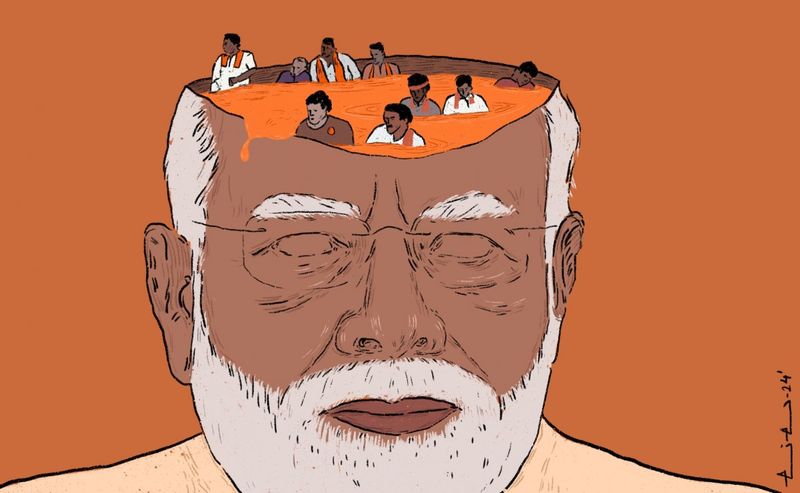Now that we have had a considerable cooling period, it is imperative to ask whether a war was the only response possible to the terrorists’ outrage in Pahalgam.
All wars inevitably produce unpredictable changes in the institutional equation between soldier, politician and citizen. The (supposedly ‘paused’) Operation Sindoor is no exception. Undesirable calculations have already seeped in to our civil-military equations. This cannot be welcome news for the polity. An unhealthy militarism has strengthened its stranglehold on our national imagination.
Inexplicably, while our otherwise voluble political demagogues are being coy about the outcome of the four-day war with Pakistan, it is the military men who are adding to our understanding of what we did right and perhaps what we could do differently.
First, it was the Chief of Defence Staff who chose to travel all the way to Singapore to reveal some nuggets about Operation Sindoor. Speaking to two foreign correspondents, General Anil Chauhan had the soldier’s self-confidence to admit the loss – without specifying the number – of our aircraft in the shoot-out with Pakistan’s air defences. Strong and vibrant nations do not flinch from taking a bit on the chin. However, our new rulers – who habitually wrap themselves up in national security colours – could not bring themselves up to tell the nation about the lost fighter jet(s) even as military observers around the world were wildly speculating over the extent of our losses.
Then, a few weeks later, thanks to a naval attache with our mission in Jakarta, we learnt how our air force performance was handicapped by a very narrow mandate given to it by the political bosses. This becomes critically significant because the nation had been told, with considerable fanfare, that our armed forces have been given a free hand to find the best way to take revenge for the Pahalgam outrage.
Indeed, there was no mystery about the mandate. The limit of that mandate itself was detailed, rather self-importantly, in the press note issued within hours of the launch of the Operation Sindoor; the very tone of that public posturing was that Pakistan should be grateful the Modi regime had spared it bigger pain and had confined its punishment to the “terror infrastructure.” The in-house darbaris, who double up as strategic wizards, were probably working on the assumption that “Rawalpindi” would understand Prime Minister Modi’s compulsion to live up to his (self-manufactured) image as the leader who had to be seen as inflicting pain and punishment on “terrorists.”
Collectively, we had righteously convinced ourselves that we had a legitimate right to punish Pakistan for atrocities committed by a handful of terrorists in an area under our control. Even that great military genius, Mohan Bhagwat of Nagpur, had publicly reminded the rulers of their sacred duty to protect the citizens.
This was strategic hocus-pocus. The fatal assumption was that Pakistan did not have any kind of effective air defence system and that the Pakistanis would just allow our air force to do what it wanted to do. Such a “mistake” – to use the expression preferred by Gen. Chauhan in his conversations in Singapore – could only be made when professional military minds allow themselves to the bamboozled by politicians, strutting around as battle-field commanders.
On the other hand, General Asim Munir, now Field Marshal, had all his ducks in a row. He had resolved that 2025 was not going to be 2019. They were ready for us. Not only that, as another Indian officer, Lt Gen. Rahul Singh, deputy chief of the army was to reveal, the Pakistani response was being quarter-backed by the Chinese. Not with just weapons but with real time intelligence inputs, affording the Pakistani brass with a peek into our deployments.
What a colossal misreading of the enemy and his state of preparedness, worse even than Jawaharlal Nehru’s misjudgment about the Chinese intentions in 1962.
But such is the high esteem the country has for the armed forces that no one wants to ask the obvious question about the (in)adequacy of our military intelligence on the Pakistan-China jugalbandi. The noisy war-drummers have maintained a strategic silence over this grave lapse. No less puzzling is the silence of the ultra-deshbhakts over our defence minister, Rajnath Singh, having a pow-wow with his Chinese counter-part even after the deeply sobering revelations made by Gen. Rahul Singh of China’s involvement in the four-day war.
The four-day war was a mismatch of the leading personalities and their skills and habits.
On one side was a mean and lean general – mocked in our media as a jihadi – whose decision-making was guided by unsentimental, cold analysis, and unburdened with any “image.” On our side was an ageing leadership, frozen in its own self-exaltation and in thrall of violence irrespective of military wisdom. The “Rawalpindi” brass had sized up Modi correctly – that he would not be able to resist the clamour for “revenge” from his own constituency – and so the Pakistan Air Force was ready with a robust response.
A month is too long a time in Indian politics. Other distractions – an air crash in Ahmedabad and a rogue president in the White House – have allowed the political crowd to get away from the blunders committed since Pahalgam; and, make no mistake, these blunders arose out of intellectual flabbiness and political arrogance. But now that we have had a considerable cooling period, it is imperative to ask whether a war was the only response possible to the terrorists’ outrage in Pahalgam. Since the four-day war, Field Marshal Munir has repeated his “Kashmir being Pakistan’s jugular vein” theme and has even argued that “terrorists” are some kind of freedom fighters. Have we trapped ourselves in the stunted imagination of our rulers and their infatuation with kinetic options?
Harish Khare is a former editor-in-chief of The Tribune.
The Wire is now on WhatsApp. Follow our channel for sharp analysis and opinions on the latest developments.
